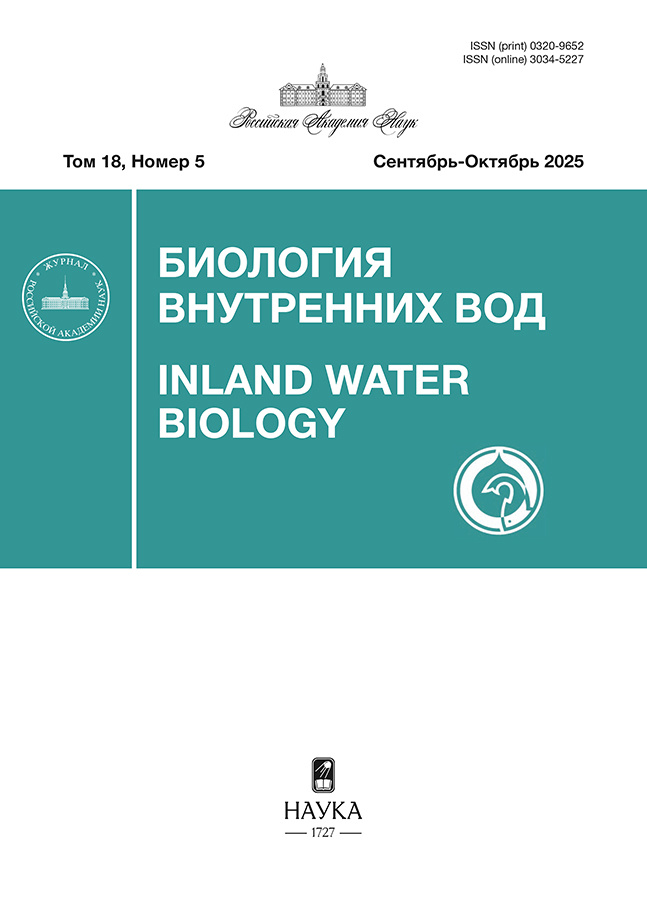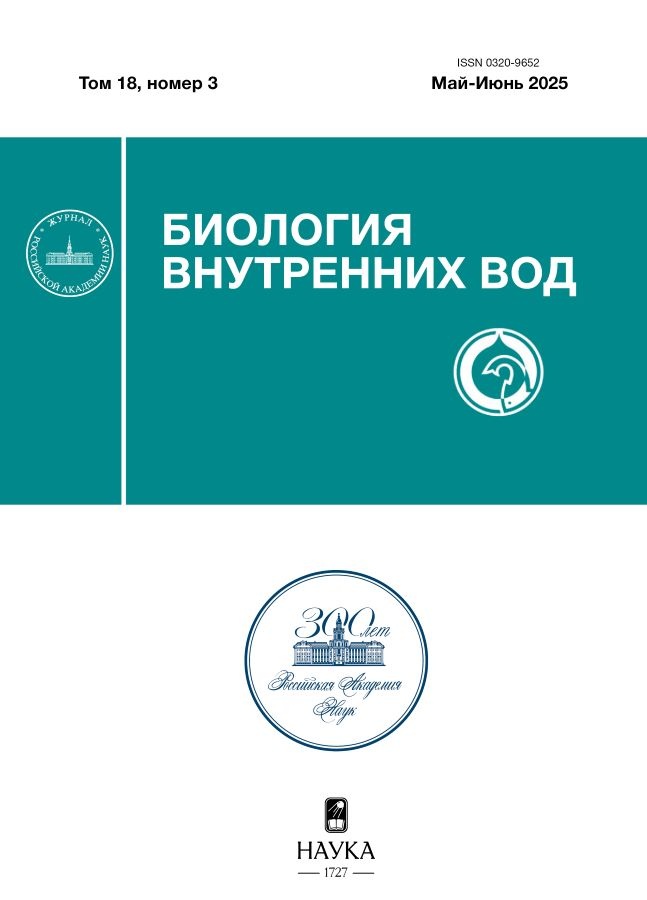Генетическая изменчивость речного окуня Perca fluviatilis в озерно-речной системе Национального парка “Себежский”
- Авторы: Семенова А.В.1,2, Мельникова М.Н.1, Пивоваров Е.А.1, Павлов С.Д.1, Хохряков В.Р.3, Кислица Е.Е.1
-
Учреждения:
- Московский государственный университет им. М.В. Ломоносова
- Институт общей генетики Российской академии наук им. Н.И. Вавилова
- Национальный парк “Себежский”
- Выпуск: Том 18, № 3 (2025)
- Страницы: 488–497
- Раздел: ИХТИОЛОГИЯ
- URL: https://vietnamjournal.ru/0320-9652/article/view/686990
- DOI: https://doi.org/10.31857/S0320965225030099
- EDN: https://elibrary.ru/IYBLSD
- ID: 686990
Цитировать
Полный текст
Аннотация
На основании 10 микросателлитных локусов ядерной ДНК впервые проведен анализ генетической изменчивости речного окуня Perca fluviatilis (L., 1758) из четырех водных объектов Национального парка “Себежский” Себежского р-на Псковской обл., входящих в единую озерно-речную систему. Средние оценки аллельного разнообразия микросателлитных локусов и наблюдаемой гетерозиготности были A = 8.87 и HE = 0.694 и достоверно не различались между исследованными локальностями. Общая генетическая дифференциация окуня составила θ = 0.002, 95% CI (–0.0007; 0.005) и была достоверно незначимой. Популяционно-генетическая структурированность на основании исследованных мультилокусных генотипов методом анализа Байеса не выявлена. Полученные данные свидетельствуют о высоком уровне потока генов у окуня на всей исследованной акватории и дают возможность предположить наличие генетически единой панмиксной популяции в системе себежских озер и рек.
Полный текст
Об авторах
А. В. Семенова
Московский государственный университет им. М.В. Ломоносова; Институт общей генетики Российской академии наук им. Н.И. Вавилова
Автор, ответственный за переписку.
Email: seman2000@yandex.ru
Россия, Москва; Москва
М. Н. Мельникова
Московский государственный университет им. М.В. Ломоносова
Email: seman2000@yandex.ru
Россия, Москва
Е. А. Пивоваров
Московский государственный университет им. М.В. Ломоносова
Email: seman2000@yandex.ru
Россия, Москва
С. Д. Павлов
Московский государственный университет им. М.В. Ломоносова
Email: seman2000@yandex.ru
Россия, Москва
В. Р. Хохряков
Национальный парк “Себежский”
Email: seman2000@yandex.ru
Россия, Псковская обл., Себежский р-н
Е. Е. Кислица
Московский государственный университет им. М.В. Ломоносова
Email: seman2000@yandex.ru
Россия, Москва
Список литературы
- Александров Ю.В., Курьянович В.И. 2001. Миноги (Petromyzonidae, Cyclostomata) и рыбы (Pisces) // Биоразнообразие и редкие виды Национального парка “Себежский”. СПб.: Тр. СПбОЕ. Сер. 6. Т. 4. С. 199.
- Атлас пресноводных рыб России. 2002. М.: Наука. Т. 2. С. 64.
- Бачевская Л.Т., Переверзева В.В., Агапова Г.А., Примак А.А. 2023. Генетическое разнообразие речного окуня (Perca fluviatilis Linnaeus, 1758) из некоторых рек России // Успехи соврeм. биол. T. 143. № 3. С. 261. https://doi.org/10.31857/S0042132423030031
- Берг Л.С. 1949. Рыбы пресных вод СССР и сопредельных стран. М..: Изд-во АН СССР. Т.3. С. 1031.
- Вейр Б.C. 1995. Анализ генетических данных. М.: Мир.
- Жигилева О.Н., Егорова А.Г., Сарьянова А.В. 2019. Морфология и генетическая изменчивость речного окуня Perca fluviatilis (Percidae) речных и озерных экосистем Западной Сибири // Вестн. рыбохоз. науки. Т. 6. № 3(23). С. 4.
- Жигилева О.Н., Егорова А.Г., Хохлов Д.А. 2017. Особенности генетики популяций некоторых видов хищных рыб Обь-Иртышского бассейна. Проблемы популяционной биологии // Матер. ХII Всерос. популяционного семинара. С. 91.
- Кашулин Н.А., Лукин А.А., Амундсен П.А. 1999. Рыбы пресных вод Субарктики как биоиндикаторы техногенного загрязнения. Апатиты: Изд-во Кольского науч. центра РАН.
- Лакин Г.Ф. 1990. Биометрия. М.: Изд-во “Высш. шк.”.
- Лобырев Ф.С., Пивоваров Е.А., Хохряков В.Р., Павлов С.Д. 2023. Популяционные характеристики плотвы, густеры и окуня в оз. Озерявки (Национальный парк “Себежский”) // Тр. ВНИРО. Т. 191. С. 37. https://doi.org/10.36038/2307-3497-2023-191-37-52
- Лобырев Ф.С., Семенова А.В., Мельникова М.Н. и др. 2024. Генетические особенности популяции леща Abramis brama из озерной системы национального парка “Себежский” // Биология внутр. вод. № 4. С. 604. https://doi.org/10.31857/S0320965224040087
- Правдин И.Ф. 1966. Руководство по изучению рыб (преимущественно пресноводных). М.: Изд-во “Пищ. пром-сть”.
- Behrmann-Godel J., Gerlach G., Eckmann R. 2006. Kin and population recognition in sympatric Lake Constance perch (Perca fluviatilis L.): can assortative shoaling drive population divergence // Behav. Ecol. Sociobiol. V. 59. P. 461. https://doi.org/10.1007/s00265-005-0070-3
- Belfiore N.M., Anderson S.L. 2001. Effects of contaminants on genetic patterns in aquatic organisms: a review // Mutat. Res. V. 489. P. 97. https://doi.org/10.1016/S1383-5742(01)00065-5
- Bergek S., Björklund M. 2007. Cryptic barriers to dispersal within a lake allow genetic differentiation of Eurasian perch // Evolution. V. 61. P. 2035. https://doi.org/10.1111/j.1558-5646.2007.00163.x
- Bergek S., Björklund M. 2009. Genetic and morphological divergence reveals local subdivision of perch (Perca fluviatilis L.) // Biol. J. Linn. Soc. V. 96. P. 746. https://doi.org/10.1111/j.1095-8312.2008.01149.x
- Bergek S., Olsson J. 2009. Spatiotemporal analysis shows stable genetic differentiation and barriers to dispersal in the Eurasian perch (Perca fluviatilis L.) // Evol. Ecol. Res. V. 11. P. 827.
- Bergek S., Sundblad G., Björklund M. 2010. Population differentiation in perch Perca fluviatilis: Environmental effects on gene flow // Fish Biol. V. 76. P. 1159. https://doi.org/10.1111/j.1095-8649.2010.02565.x
- Bodaly R A., Ward R.D., Mills C.A. 1989. A genetic stock study of perch, Perca fluviatilis L., in Windermere // Aquat. Sci. P. 965. https://doi.org/10.1007/BF00878023
- Butkauskas D., Ragauskas A., Sruoga A. et al. 2012. Investigations into genetic diversity of the perch inhabiting Ignalina nuclear power plant cooler and other inland water bodies of Lithuania on the basis of mtDNA analysis // Veterinarija ir Zootechnika. V. 60. P. 7.
- DeWoody J.A., Avise J.C. 2000. Microsatellite variation in marine, freshwater and anadromous fishes compared with other animals // J. Fish Biol. V. 56. P. 461. https://doi.org/10.1111/j.1095-8649.2000.tb00748.x
- DiBattista J.D. 2008. Patterns of genetic variation in anthropogenically impacted populations // Conserv. Genet. V. 9. P.141. https://doi.org/10.1007/s10592-007-9317-z
- Ericson G., Lindesjöö E., Balk L. 1998. DNA adducts and histopathological lesions in perch (Perca fluviatilis) and northern pike (Esox lucius) along a polycyclic aromatic hydrocarbon gradient on the Swedish coastline of the Baltic Sea // Can. J. Fish Aquat. Sci. V. 55. P. 815. https://doi.org/10.1139/f97-296
- Ericson G., Larsson A. 2000. DNA adduct in perch (Perca fluviatilis) living in coastal water polluted with bleached pulp mill effluents // Ecotoxicol. Environ. Safety. V. 46. P. 167. https://doi.org/10.1006/eesa.1999.1892
- Eschbach E., Nolte A.W., Kohlmann K. et al. 2021. Genetic population structure of a top predatory fish (northern pike, Esox lucius) covaries with anthropogenic alteration of freshwater ecosystems // Freshwater Biol. V. 66. P. 884. https://doi.org/10.1111/fwb.13684
- Faulks L.K., Gilligan D.M., Beheregaray L.B. 2011. The role of anthropogenic vs. natural in stream structures in determining connectivity and genetic diversity in an endangered freshwater fish, Macquarie perch (Macquaria australasica) // Evol. Appl. V. 4. P. 589. https://doi.org/10.1111/j.1752-4571.2011.00183.x
- Fokina O., Grauda D., Rashal I. 2015. Genetic diversity of two perch Perca fluviatilis populations of the Latgale region, Environment // Tech. Res. V. 11. P. 96. https://doi.org/10.17770/etr2015vol2.280
- Gerlach G., Schardt U., Eckmann R., Meyer A. 2001. Kin-structured subpopulations in Eurasian perch (Perca fluviatilis L.) // Heredity. V. 86. P. 213. https://doi.org/10.1046/j.1365-2540.2001.00825.x
- Gharibkhani M. 2009. The genetic structure and phylogenetics of pikeperch (Sander lucioperca) Anzali and Amirkolaye wetlands and perch (Perca fluviatilis) populations in Aras Dam and south-west of the Caspian Sea. PhD Thesis, Islamic Azad University, Science and Research Branch, Tehran.
- Hedgecock D. 1994. Does variance in reproductive success limit effective population size of marine organisms in genetics and evolution of aquatic organisms. London: Chapman & Hall.
- Imbrock F., Appenzeller A., Eckmann R. 1996. Diet and seasonal distribution of perch in Lake Constance: a hydroacoustic study and in situ observations // J. Fish Biol. V. 49. P. 1.
- Kalinowski S.T., Wagner A.P., Taper M.L. 2006. ML-Relate: a computer program for maximum likelihood estimation of relatedness and relationship // Mol. Ecol. V 6. P. 576. https://doi.org/10.1111/j.1471-8286.2006.01256.x
- Karås P., Neuman E., Sandström O. 1991. Effects of a pulp mill effluent on the population dynamics of perch, Perca fluviatilis // Can. J. Fish Aquat. Sci. V. 48. P. 28. https://doi.org/10.1139/f91-004
- Khadher S.B., Agnèse J.F., Milla S. et al. 2015. Patterns of genetic structure of Eurasian perch (Perca fluviatilis L.) in Lake Geneva at the end of the spawning season // J. Great Lakes Res. V. 4. P. 846. https://doi.org/10.1016/j.jglr.2015.04.006
- Kipling C., Le Cren E.D. 1984. Mark recapture experiments on fish in Windermere // J. Fish. Biol. V. 24. P. 395. https://doi.org/10.1111/j.1095-8649.1984.tb04811.x
- Lewis P.O., Zaykin D. 2001. Genetic Data Analysis: Computer program for the analysis of allelic data. Version 1.0 (d 16c). Free program distributed by the authors over the internet from https://lewis.eeb.unconn.edu/lewishome/software.html
- Lindesjöö E., Thulin J. 1990. Fin erosion of perch Perca fluviatilis and ruffe Gymnocephalus cernua in a pulp mill effluent area // Dis. Aquat. Organ. V. 8. P. 119. https://doi.org/10.3354/dao008119
- Mantel N. 1967. The detection of disease clustering and a generalized regression approach // Cancer Research. V. 27. P. 209.
- Nesbø C., Magnhagen C., Jakobsen K. 1998. Genetic differentiation among stationary and anadromous perch (Perca ftuviatilis) in the Baltic Sea // Hereditas. V. 129. P. 241. https://doi.org/10.1111/j.1601-5223.1998.00241.x
- Nesbø C., Fossheim T., Vollestad L., Jakobsen K. 1999. Genetic divergence and phylogeographic relationships among European perch (Perca fluviatilis) populations reflect glacial refugia and postglacial colonization // Mol. Ecol. V. 8. P. 1387. https://doi.org/10.1046/j.1365-294x.1999.00699.x
- Olsson J., Mo K., Florin A.B. et al. 2011. Genetic population structure of perch Perca fluviatilis along the Swedish coast of the Baltic Sea // J. Fish Biol. V. 79. P. 122. https://doi.org/10.1111/j.1095-8649.2011.02998.x
- Piry S., Luikart G., Cornuet J.M. 1999. Computer note. BOTTLENECK: a computer program for detecting recent reductions in the effective size using allele frequency data // J. Heredity. V. 90. P. 502. https://doi.org/10.1093/jhered/90.4.502
- Pritchard J.K., Stephens M., Donnelly P. 2000. Inference of population structure using multilocus genotype data // Genetics. V. 155. P. 945. https://doi.org/10.1093/genetics/155.2.945
- Ragauskas A., Ignatavičienė I., Rakauskas V. et al. 2023. Trends of eurasian perch (Perca fluviatilis) mtDNA ATP6 region genetic diversity within the hydro-systems of the eastern part of the Baltic Sea in the anthropocene // Animals. V. 13. P. 3057. https://doi.org/10.3390/ani13193057
- Raymond M., Rousset F. 1995. GENEPOP (version 1.2): Population genetics software for exact tests and ecumenicism // J. Heredity. V. 8. P. 248. https://doi.org/10.1093/oxfordjournals.jhered.a111573
- Rice W.R. 1989. Analyzing tables of statistical tests // Evolution. V. 43. P. 223. https://doi.org/10.1111/j.1558-5646.1989.tb04220.x
- Říha M., Hladík M., Mrkvička T. et al. 2013. Post-spawning dispersal of tributary spawning fish species to a reservoir system // Folia Zoologica. V. 62. P. 1. https://doi.org/10.25225/fozo.v62.i1.a1.2013
- Slatkin M. 1985. Gene flow in natural populations // Ann. Rev. Ecol. Syst. V. 16. P. 393.
- Oosterhout C., Hutchinson W.F., Wills D.P.M., Shipley P. 2004. MICRO-CHECKER: software for identifying and correcting genotyping errors in microsatellite data // Mol. Ecol. Notes. V. 4. P. 535. https://doi.org/10.1111/j.1471-8286.2004.00684.x
- Wang N., Eckmann R. 1994. Distribution of perch (Perca fluviatilis L.) during their first year of life in Lake Constance // Hydrobiologia. V. 277. P. 135. https://doi.org/10.1007/BF00007295
- Waples R.S. 1998. Separating the wheat from the chaff: patterns of genetic differentiation in high gene flow species // J. Heredity. V. 89. P. 438. https://doi.org/10.1093/jhered/89.5.438
- Weir B.S., Hill W.G. 2002. Estimating F-statistics // Ann. Rev. Genet. V. 36. P. 721. https://doi.org/10.1146/annurev.genet.36.050802.093940
- Wright S. 1943. Isolation by distance // Genetics. V. 28. P. 114.
- Wright S. 1951. The genetical structure of populations // Ann. Eugenics. V. 15. P. 323.
- Xu P., Lu C., Sun Z. et al. 2022. In silico screening and development of microsatellite markers for genetic analysis in Perca fluviatilis // Animals. V. 12. P. 1809. https://doi.org/10.3390/ani12141809
- Zamora L., Moreno-Amich R. 2002. Quantifying the activity and movement of perch in a temperate lake by integrating acoustic telemetry and a geographic information system // Aquatic telemetry: proceedings of the fourth conference on fish telemetry in Europe. Netherlands: Springer. https://doi.org/10.1023/A:1021396016424
- Zhigileva O.N., Egorova A.G. 2022. Genetic variability and phenotypic diversity in populations of the Eurasian perch, Perca fluviatilis (Actinopterygii, Percidae) // Acta Biol. Sibirica. V. 8. P. 237. https://doi.org/10.1134/S2079086423060026
Дополнительные файлы












